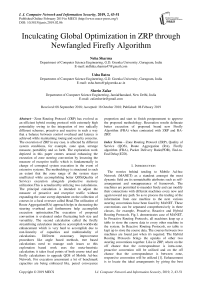Inculcating global optimization in ZRP through newfangled firefly algorithm
Автор: Neha Sharma, Usha Batra, Sherin Zafar
Журнал: International Journal of Computer Network and Information Security @ijcnis
Статья в выпуске: 2 vol.11, 2019 года.
Бесплатный доступ
Zone Routing Protocol (ZRP) has evolved as an efficient hybrid routing protocol with extremely high potentiality owing to the integration of two radically different schemes, proactive and reactive in such a way that a balance between control overhead and latency is achieved while maintaining routng and security concerns. The execution of ZRP in any case, is affected by different system conditions, for example, zone span, arrange measure, portability and so forth. The exploration work depicted in this paper centers around enhancing the execution of zone steering convention by lessening the measure of receptive traffic which is fundamentally in charge of corrupted system execution in the event of extensive systems. The methodology is structured to such an extent that the zone range of the system stays unaffected while accomplishing better QOS(Quality of Service) execution alongside productive memory utilization.This is actualized by utilizing two calculations. The principal calculation is intended to adjust the measure of proactive and receptive traffic without expanding the zone sweep dependent on the collection of courses in a focal overseer called Head.The utilization of Route Aggregation(RA) approach helps in decreasing the steering overhead and furthermore help accomplish execution optimization.The execution of proposed convention is evaluated under fluctuating hub size and versatility. The second calculation called the firefly streamlining calculation intends to accomplish worldwide enhancement which is very hard to accomplish due to non-linearity of capacities and multimodality of calculations. Different customary improvement procedures like angle based methods, tree based calculations need to manage such issues so this exploration based work uses the meta-heuristic calculation; it takes focal points of both course total and firefly calculations to upgrade QOS of Mobile Ad-hoc Network. For execution assessment a lot of benchmark capacities are being embraced like, parcel conveyance proportion and start to finish postponement to approve the proposed methodology. Recreation results delineate better execution of proposed brand new Firefly Algorithm (FRA) when contrasted with ZRP and RA-ZRP.
Zone Routing Protocol (ZRP), Quality of Service (QOS), Route Aggregation (RA), Firefly algorithm (FRA), Packet Delivery Ratio(PDR), End-to-End Delay(E2D)
Короткий адрес: https://sciup.org/15015668
IDR: 15015668 | DOI: 10.5815/ijcnis.2019.02.06
Текст научной статьи Inculcating global optimization in ZRP through newfangled firefly algorithm
The worries behind tending to Mobile Ad-hoc Network (MANET) as a standout amongst the most dynamic field are its unmatchable attributes such as selfarrangement and nonappearance of framework. The machines are permitted to meander freely and can modify their connections with different machines every now and again toward any path. So as to process the trading of the information from one machine to the next various steering conventions have been fused by MANET. These conventions can be separated comprehensively in three classes, for example, Proactive, Reactive and Hybrid Routing Protocols. Fig.1. demonstrates case of MANET. In Proactive Routing Protocols, all machines keep up a table to store the course data to every other machine in the system. In Reactive Routing Protocols, no table is kept up to store the course data. The courses between two machines are found just when it's required. The Hybrid Routing Protocols brings the upsides of other two steering conventions together. Like in ZRP, where on the off chance that the correspondence is intra-zone, proactive convention will be utilized and on the off chance that the correspondence is between zone, responsive convention will be utilized [1]. Enhancement is to locate the ideal arrangements by giving the best qualities to any capacity and to accomplish this different streamlining strategies are utilized. One of the cutting edge meta-heuristic calculations dependent on swarm knowledge is Firefly Algorithm (FRA). The Firefly Algorithm has developed quick for practically all regions of improvement. It delivers short and musical flashes called 'Bioluminescence'. The essential capacity of 'Bioluminescence' is to convey to their accomplices, to draw in potential prey and to give defensive cautioning towards the predator. The two essential factors in Firefly Algorithm are the light force and the appeal. The light force diminishes as the separation increments and the firefly is pulled in towards the other firefly that has more brilliant blaze than itself. The brilliance of the blaze again relies on the light power. The veneration of un-stationary machines and line free systems has hoisted superlatively in the course of the last couple of year. Therefore MANET has lingered famously in the areas of innovative work of line free systems. MANET has developed into a standout amongst the most vivacious spaces of correspondence in string free innovation. Pursued by are the top to bottom examination of ZRP, RA and FRA, which are the key techniques of this exploration investigation.
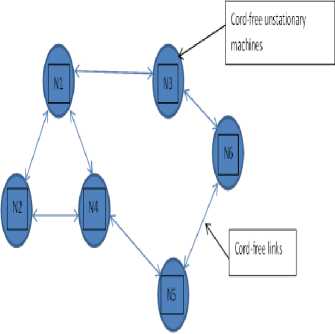
Fig.1. Example of MANET Network
-
A. Zone Routing Protocol
Zone Routing Protocol is supported on three noteworthy conventions. In any case, ZRP needs the assistance of another convention called Neighbor Discovery Protocol (NDP) in starting the acknowledgment of the neighbors inside the remote scope of the zone. This is acknowledged by transmitting the appreciated messages as "Hi", finding out the one jump removed hubs. It additionally is in charge of sending the intermittent refresh messages to keep a refreshed record of the neighbors. The other strong convention for ZRP is Intra Zone Routing Protocol (IARP). It takes forward from the NDP which keeps up the IARP table inside the Zone. Fig.2. portrays directing structure of ZRP. It acts proactively and keeps up the refreshed record of the courses inside the zone and in this manner withdraws in quicker course assurance. The conveyance of information bundles assigned to hubs outside the zone of the sender hub are steered on interest simply after the conveyance is asked for, through another convention called Inter Zone Routing Protocol (IERP). It works by bordercasting the course demands to the fringe hubs and after that endeavoring to discover the goal. The convention is known as the Bordercasting Resolution Protocol [1,2,3,4,5,6] that guarantees measures to maintain a strategic distance from pointless flood of course inquiries by utilizing certain control measures.
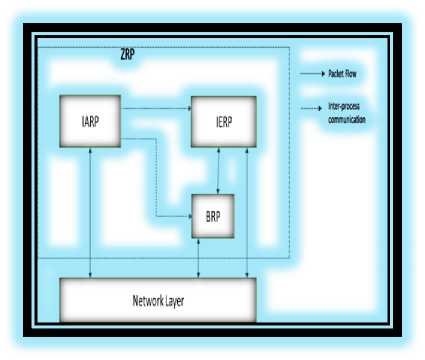
Fig.2. ZRP Routing
-
B. Route Aggregation
Amid the mid 1990's the point at which the web began winding up progressively well known and fruitful the real battle confronted was to viably discover an answer for the issues emerging because of the relatively developing sizes of the steering tables keeping in view the constrained capacity of the switch in pleasing the measure of directing table records. The expanding gadgets on the web likewise influenced the debilitating delivers to be distributed to each gadget. In this way, it ended up essential to discover a goals to the location fatigue issue in the web. To counter these rising obstructions in the way of developing web, the network of systems administration, turned to an answer of total of courses [1,2,3,4,5,6]. The accumulation procedure settled the issue of keeping up the expanded number of courses by every switch as a result of the expansion in the quantity of gadgets associated into the web by diminishing the measure of steering table records in IP represented system. Course conglomeration works by bringing together explicit aggregate courses and substituting the declaration for these courses to different systems by a solitary course. In this manner, the numerous courses determining the way to be taken are covered up by a solitary course declaration as delineated in Fig.3. The main conceptualization of total methodology initiates by naming an adjacent arrangement of addresses to an ISP and the ISP as opposed to reporting the whole arrangement of courses relating to every switch inside its system, just announces a solitary increasingly broad location as the switch address Thus, sparing a great deal of thorough tends to likewise sparing the measure of directing tables sections to be recorded[1,2,3,4,5,6].
This methodology ends up being powerful in improving the idleness even on account of complex topology systems. The decrease in the measure of directing records to be kept up with the expansion in the quantity of gadgets inside the web likewise limits the overhead on the conventions empowering steering in the system. This likewise enhances the dependability and versatility as the adjustment in topology will likewise require less steering updates, diminishing the outstanding task at hand on the processor alongside enhancing the memory and transfer speed demands[1,2,3,4,5,6],thus giving compelling directing answer for MANET.
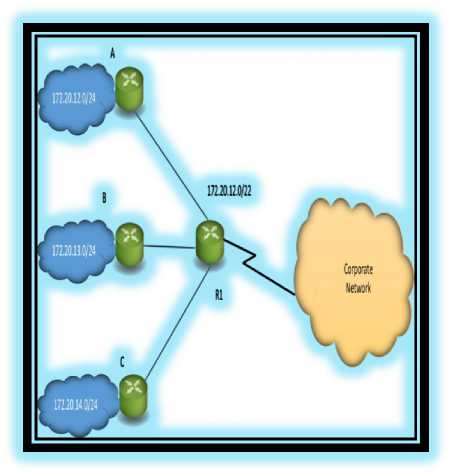
Fig.3. Route-Aggregation Technique Applied in Internet
The proposed productive half breed directing convention utilizes the powerful steering collection and firefly enhancement technique so as to defeat the different issues in charge of debasing the execution of ZRP. The remotely associated compact gadgets working without framework, going about as switches to empower correspondence are significantly influenced by the restricted assets and to a great extent by the progressively differing topology.The endeavors in this paper go for enhancing the execution of ZRP under horrible conditions. NS2 test system is utilized for examination. The benefit of the calculation proposed in his paper, is the use of system which renders the outperforming of bordercasting component utilized by ZRP and in this way decreasing the measure of copy ask for bundles because of covering zones and consequently sparing the system from flooding and this is conceivable with the assistance of utilization of conglomeration at the zone head.
-
C. Firefly Algorithm(FRA)
The firefly calculation extricates the conduct of correspondence of the tropical fireflies and behavious admired of their glimmering examples and assembles the scientific model of the calculation following the essential three glorified standards introduced beneath and furthermore portrayed in Fig.4.
-
i) The nature of fireflies is unisex therfefore they are pulled in towards one another paying little mind to their sex
-
ii) Their allure is corresponding to their brilliance for example the less splendid the firefly will
dependably be pulled in to the more splendid firefly subsequently the engaging quality of the firefies is straightforwardly corresponding to their brilliance and the allure diminishes as the separation between the firefly increments.
-
iii) Also the brilliance of firefly is additionally dictated by the target capacities scene hence in a boost issue the splendor is essentially corresponding to the target capacities esteem. The firefly calculation pursues two fundamental and essential purposes of light force definitions and change of the allure. The firefly splendor is dictated by the scene of the target work and the light power variety is characterized and detailed with the adjustment in the engaging quality.
The light force in nature diminishes with sources separation and media ingests light thusly in the firefly reenactment strategy light power (I) differs monotically and exponentially with separation ( r ) and the light absorbtion parameter γ as portrayed in condition 1.
I=I0 e^(- γr^2 ) (1)
where:
-
:I0 is the first light force at the source (i.e., at the separation r = 0) and
:γ is the light assimilation coefficient
Light appealing coefficient β can likewise be characterized in the comparable path underneath:
β=β0 e^(-γr^2 ) (2)
where:
-
:β0 is the first light allure at r = 0.
Cartesian separation is used for computing separation between any two fireflies q and p at xq and xp portrayed in condition 3.
xp=xp+β=β0e^(- γr^2)(xq-xp)+εαi (3)
The measure of development of firefly q to another progressively appealing (more splendid) firefly p is controlled by condition 4:
xp=xp+β=β0e^(- γr^2)(xq-xp)+εαi (4)
-
i) Objective function of firefly streamlining calculation is given as:
Objective function f(x), x = (x1,_ _ _,xD)T
-
ii) Population of fireflies is initialized based on the following parameters:
Initialize a population of fireflies xi (i = 1,2,_ _ _n) iii) Next step calculates light intensity of fireflies based on the light absorption parameter given as:
Calculate the light intensity Ip at xp by f(xp) Define light absorption coefficient γ
While (t < MaxGeneration) for i = 1:n all n fireflies for j = 1:n all n fireflies
-
iv) Cartesian distances is then calculated as:
Calculate the distance r between xp and xj using Cartesian distance equation if (Iq > Ip)
-
v) Attractiveness of fireflies is then varies as:
Attractiveness varies with distance r via p = p0 e~yr2
Move firefly p towards q in all d dimensions end if
-
vi) New solutions are then evaluated and light intensity is being updated as:
Evaluate new solutions and update light intensity end for j end for i
-
vii) Fireflies are then ranked to find the current best firefly is found out as:
Rank the fireflies and find the current best end while
-
viii) Results are processed and visualized as:
Post-process results and visualization
-
Fig.4. Firefly Algorithm
where:
:first term in above condition is the present area of firefly p,
:second term in above condition is because of the fascination,
:third term is randomization with the vector of arbitrary factors εi that are being drawn Uniform and Gaussian appropriation and Lévy flight.
:α is a scaling parameter that is used to controls the progression size and it ought to be connected with the interests of the issues.
Rest of the paper is composed as pursue: Section II list about the writing overview which incorporates related work and paper with respect to firefly calculation, ZRP and RA. Holes of study which lead to issue detailing of proposed methodology are featured in Section III. Philosophy received for brand new FRA approach is talked about in Section IV. Area V incorporates reproduction results and investigation. End and future extension is incorporated into Section VI.
-
II. Literature Review
A broad writing study about the Firefly Algorithm and ZRP is given in this segment. Writing audit in table.1depicts broad investigation that helps in creating holes of concentrate that lead to issue definition of the proposed methodology.
Table 1. Literature Survey
|
S No. |
Author Name |
Outcome of Research Analysis |
|
1 |
A. Galvez and A. Iglesias [7] |
This paper displays the firefly calculation as an answer for the parameterization issue for polynomial Bezier surfaces. The Firefly Algorithm turns out to be a solid nature motivated metaheuristic calculation that has been utilized on an expansive scale so as to tackle extreme streamlining issues. This paper features the fruitful use of Firefly Algorithm to a few examples of open and shut surfaces and the outcomes for similar demonstrates that the calculation carries on splendidly and brings the best approximating surface alongside an upraised level of exactness. This paper basically centers around the pivotal issues, for example, the arrangement portrayal and the choice of appropriate control parameters. |
|
2 |
D. G. Armstrong, D. M. Kleidermacher, et.al. [8] |
In this paper the creators centers around the security of remote gadgets. The essential spotlight is on the restorative gadget hacking which has been alluded as "Medjacking". A system for making security for remote wellbeing gadgets that depends on global normal criteria has been proposed. The thought behind this is to concede for ceaseless development and alteration while keeping security, open trust and certainty forward in parallel. |
|
3 |
S. M. Farahani, A. A. Abshouri et al. [9] |
In this paper, another Firefly Algorithm has been inferred and an examination investigation of the ordinary Firefly and the recently determined Firefly has been given. The two most imperative parts of a firefly calculation for example the light force and the engaging quality has been engaged in the paper. The primary thought process of planning another rendition of Firefly Algorithm is to balance out firefly's development and to expand transformation speed. The recently determined calculation was analyzed on five standard capacities that has utilized for look at the static streamlining calculation. The outcomes in this manner brought from the examination demonstrates preferable and progressively precise execution over ordinary firefly calculation. |
|
4 |
N. F. Johri, A. M. Zain, et al. [10] |
In this paper, the creators have utilized firefly calculation in first stage. The most lively highlights of fireflies, for example, blazing conduct and the marvel of bioluminescence correspondence have been utilized so as to enhance the machining parameters, for example, feed rate, profundity of cut and axle speed. In second stage the firefly calculation is hybridized with PSO so as to get better result. In view of the outcomes, the mixture Firefly Algorithm and PSO Found to be More proficient for multi target advancement issues. |
|
5 |
S. Markel, C. W. Becker et al. [11] |
In this paper, creators talk about the disappointments of bringing precise position subtleties of cell phones in a MANET. The fundamental explanation for this is absence of data, inaccessibility of equipment and aloof required assets. Along these lines, another calculation raised by the creators that can process bounce include and is prepared getting separations between the gadgets. The essential working of the calculation depends on the synchronization of the considerable number of gadgets in a MANET. The aftereffects of test performed demonstrates that the recently structured calculation has preferable and very precise outcomes over the offbeat condition based calculation. |
|
6 |
L. Zhang, L. Liu et al. [12] |
In this paper, the creator features the impediments of conventional calculations, for example, angle based strategies that is utilized for advancement all inclusive. Creators have recommended a novel half breed approach that will consolidate the upsides of both firefly calculation and differential advancement and it is tended to as mixture firefly calculation. A lot of chosen standard capacities have been made so as to test the proficiency and precision of the proposed calculation. The outcomes portray better execution of the proposed calculation when contrasted with the customary calculation. |
|
7 |
M. Elkhechafi, Z. Benmamoun et al.[13] |
This paper illuminates the firefly calculation all the more profoundly. The firefly calculation has been introduced as a standout amongst the best and most recent bio persuaded calculation. A progressively explained examination ponder that utilizes a lot of standard test capacities has been brought out. In this paper the principle plan of this paper is to demonstrate the utilization of firefly calculation in fathoming greater and extreme advancement in store network the board framework. The firefly calculation works upon the multifaceted nature that emerged from the logical inconsistency of the minimization of the expenses and augmentation of the dimension of administration. |
|
8 |
S. L. Tilahun and J. Medard et al. [14] |
This paper expounds the firefly calculation from its advancement to the later phases of utilization. The firefly calculation was at first proposed for taking care of just consistent issues in light of the blazing conduct of fireflies. Later on, in the wake of thinking about its precision and accomplishments in taking care of persistent issues, unmistakable trials have been performed to make it versatile for discrete issues. Different alterations have been done to firefly calculation so as to make it perfect to give answer for discrete variable issues up until now, has been talked about in this paper. |
|
9 |
M. S. Manshahia [15] |
This paper features the use of firefly calculation in remote sensor organize. The significant part that needs consideration in WSN is the vitality protection. The undertaking is to plan an algorithmic technique that can distinguish the improved course while keeping all the basic parameters like lingering vitality scope of retransmission and the separation among source and goal hubs. In this paper the creator has actualized firefly calculation so as to accomplish vitality proficient steering in WSN and firefly calculation is significantly founded on the appeal of the firefly. The consequences of the equivalent has contrasted with PSO that unmistakably focuses towards the firefly calculation for best outcomes on system lifetime and throughput of the system. |
|
10 |
Loutfi et. al.[16] |
Creators have investigated the impression of shifting assorted system parameters, principally, zone span on the execution of ZRP. The proposals made in the paper are bolstered by results. The examination has yielded diverse estimations of ideal range an incentive for little and medium traffic stack and another for vital load and overwhelming hub thickness. |
|
11 |
K.I. Lakhtaria [17] |
Creators have the examination focused on measuring the ZRP execution under sensible parameters for various estimations of zone span. The reproduction is carried on Qualnet 4.0 system test system. The outcomes depict the progressions required in zone range with change in the thickness for enhancing ZRP execution. The investigation covers different applications to assess the execution. Creators have exemplified a directing convention dependent on the upgrades connected on ZRP. The alterations enable a movable and dispersed design to accomplish an ideal size of zone span. Both proactive and responsive parts are made versatile. Each hub keeps up its very own zone range dependent upon the versatility esteems. A quick moving hub keeps up a shorter zonal region while a moderate moving hub picks a bigger zone region. The execution is assessed with the assistance of NS2 test system and the outcomes are depictive of the huge upgrade of execution of ZRP. |
-
III. Research Motivation
The exceptional writing study uncovers the incredible measure of work is done so as to examine and comprehend the effect of the estimation of zone span on the execution of ZRP. With the assistance of writing overview it was discovered that an ideal estimation of .
sweep can help in diminishing the steering traffic and enhance ZRP execution. As a rule, it is required to strike a harmony between the sweep of the zone and the measure of the steering table for a very portable zone. A couple of different impediments are explained beneath:
-
1. The exact use of the receptive and proactive steering procedures render great execution for ZRP under specific situations. Be that as it may, there are different obstacles looked by ZRP. The division of system into zones on one hand spares the control overhead inside the zone yet then again the course asks for courses outside the zone end up unnecessary because of the covering of zones of hubs and because of these imitation demands the overhead on the system increments.
In instance of exceptionally expansive system, ZRP still acts proactively inside the zone and winds up keeping up a record of real courses proactively and henceforth steering overhead turns into a conspicuous and basic issue and needs an ideal estimation of sweep [18].
Whereas the proactive courses are promptly accessible yet the assurance of courses starting with one zone then onto the next requires some serious energy and consequently, causes delay because of outskirt throwing of demand and in this way, needs ideal dissemination of traffic between both the plans. The above refered to holes are illustrative of the confinements looked by the conventional ZRP directing methodology. Course Aggregation approach has turned out to be a dynamic strategy when utilized in Internet Protocol (IP). This paper gives an actualized course collection approach enhanced through brand new FRA approach in the event of ZRP convention. The following segment subtleties the novel FRA approach for decreasing the measure of the steering tables and its successful use in making strides QOS execution of ZRP.
-
IV. Methodology Adopted
The proposed philosophy depends on the issue examination and proposes another calculation that generally introduces an instrument to make congregated zones inside the system and names a set out hub toward each collected zone. Accumulated xone is a gathering of hubs greater than a ZRP zone with head hub as the focal executive. Head hub functions as a focal substance and courses the traffic into the accumulated zone by the assistance of collection instrument subsequently, improving ZRP execution. The calculation initiates its activity by introducing the zone list and including the hubs inside the chose ZRP zone of a specific hub. At that point a head hub is chosen from the rundown and spared. The calculation totals different hubs from differenr ZRP made zones by checking the outskirt hubs for new zones and including more hubs into the equivalent amassed zone arbitrarily, in this way making collected zone with head hub as the director. After the zones are totaled and the head hub is chosen, the courses are accumulated at the head hub. For transmisssion of information from source to goal over, the source at first checks with head1 hub for a course, since the course to goal isn't accessible the Route Request is bordercasted to the outskirt hubs. The outskirt hubs check their repective set out hubs toward a course. For this situation head2 is checked and since course isn't accessible again Route ask for is bordercasted and head3 is checked and after that course is annexed in the course answer message.
For further QOS advancement, Firefly Algorithm (FRA) is utilized alongside RA-ZRP instrument whose flowchart is appeared in Fig.5. Firefly calculation ascertains cost capacity utilizing Rastrigin Function. A non-arched capacity which is used as an execution test issue for improvement calculations is alluded as a Rastrigin work. Initially proposed as a 2-dimensional capacity, it exhibits a normal case of non-straight multimodal work that has been summed up by Mühlenbein et al. [19]. In advancement issues it is hard to locate the base of a capacity because of its huge inquiry space and very substantial number of neighborhood minima.
On a n-dimensional area Rastringin work is characterized by:
f(x) = An + X ”=1 [x 2 - Acos(2nxi] (5)
Where: A=10
The proposed new-fangled Firefly formula of this research work is given as:
f(x) = An + F[Z r=1 [FC 2 - Acos(2nFCl] AND
X1i=l[_DR2 - Acos(2nDRi] AND ^.[RE? -
Acos(2.TtREi\] (6)
where: A=10 //set as default; n= number of nodes in the zone; FC= Forward Count; DR= Drop Count; RE= Residual Energy
The proposed FRA-ZRP based firefly structure hence, figures out how to decrease the steering table size, lessen the control messages as less control messages are overwhelmed, diminished the deferral by conglomerating zones and conveying them closer to get to, diminishing the crashes and lines, use assets successfully and upgrade QOS parameters like, bundle conveyance proportion and start to finish postpone whose reenactment approvals are introduced in the following segment.
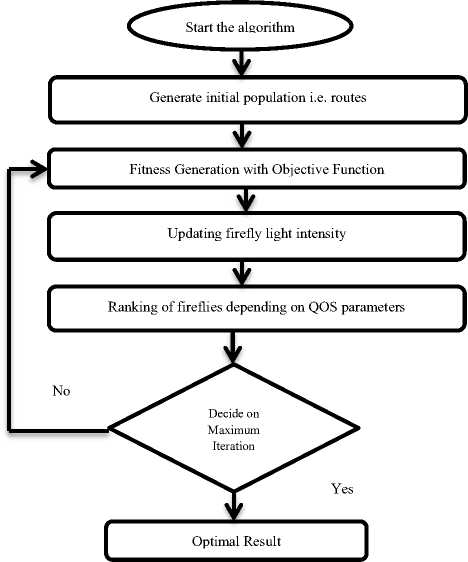
Fig.5. Flowchart for Firefly Algorithm
-
V. Results Analysis
The NS2 test system empowers the assessment of the investigation of execution of the propounded calculation. A system situation is created haphazardly where 'n' number of hubs are conveyed inside a 1000 mx1000m region. The 'n' number of hubs are shifted and execution is assessed by changing respite time. The traffic type considered is Constant Bit Rate(CBR). The span of information bundles is 512 bytes. The reproduction was conveyed for a time of 600 sec, with a hub speed of 0~20m/s. The quantity of associations considered are 20 and the parcel rate is set to 4 P/s as portrayed in Table 2.
Table 2. Simulation Setup of FRA-ZRP approach
|
Parameter |
Value |
|
Network Area |
1000x1000 m2 |
|
Velocity |
0~20m/s |
|
No. of Nodes |
50 |
|
Packet Size |
512 byte |
|
Traffic Type |
CBR |
|
Number of Connection |
20 |
|
Packet rate |
4 P/s |
|
Simulation Time |
600 sec |
|
Pause Time |
0,100,200,300,400,500,600 |
The various QOS (Quality of Service) Parameters involved in Simulation Setup include:
1. Packet Delivery Ratio
PDR is depicted by the proportion of the quantity of effectively conveyed information parcels at the goal to the no. of bundles began at the source.
PDR = A1/A2 (7)
where:
A1 is the additional consequence of the information parcels gotten by the goal.
A2 is he included consequence of the information parcels started at the source.
This is the proportion of execution of a convention which delineates the achievement accomplished by the steering convention in conveying the information bundles from the source to the goal. A high estimation of PDR shows better execution of a convention. The outcomes created by utilizing the proposed plan signalizes both the enhancement in aggregate and precision of the steering convention subsequently, enhanced dependability as delineated in Table 3., Fig.6. furthermore, Fig.7. repectively.
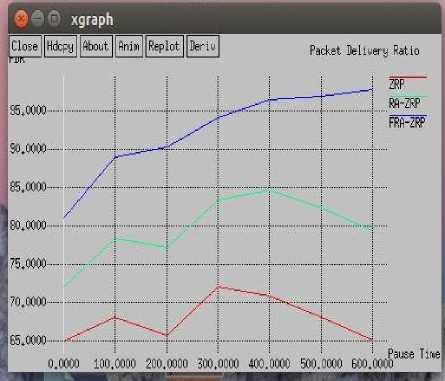
Fig.7. X-graph based simulation analysis of ZRP, RA-ZRP and FRA-ZRP on basis of PDR with varying pause time
2. End-to-End Delay (E2D)
E2D is the time contrast between sender produced parcel and reciever got bundle. It is determined by the accompanying equation:
D
end-end = N(d nodal )=N(d proc +d
queue
+d trans+dprop ) --(8)
where:
Table 3. Comparison Analysis of ZRP and RA-ZRP and FRA-ZRP on basis of PDR with varying pause time
|
PDR |
|||||||
|
0 |
100 |
200 |
300 |
400 |
500 |
600 |
|
|
ZRP |
65 |
68 |
65.7 |
72 |
70.9 |
68 |
65.2 |
|
RA- ZRP |
72 |
78.4 |
77.2 |
83.29 |
84.73 |
82.36 |
79.37 |
|
FRA-ZRP |
81 |
89 |
90.3 |
94.13 |
96.39 |
96.89 |
97.73 |
N = links between source and destination dproc= processing delay at router dqueue= queuing delay at router dtrans = transmission delay for router to put data on medium dprop= propogation delay at medium
PDR
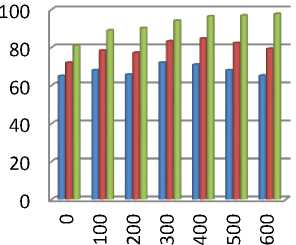
A low estimation of PDR demonstrates better execution of a convention. The outcomes created by utilizing the proposed plan signalizes diminished E2D prompting enhancement in both total and precision of the steering convention henceforth, enhanced unwavering quality as portrayed in Table 4., Fig.8. furthermore, Fig.9. individually.
ZRP
RA-ZRP
FRA-ZRP
Table 4. Comparison Analysis of ZRP, RA-ZRP and FRA-ZRP on basis of E2D with varying pause time
|
E2D |
|||||||
|
0 |
100 |
200 |
300 |
400 |
500 |
600 |
|
|
ZRP |
1.2 |
1 |
1.3 |
1.54 |
1.2 |
1.23 |
1.19 |
|
RA- ZRP |
0.9 |
0.7 |
0.84 |
0.95 |
0.92 |
0.93 |
0.89 |
|
FRA-ZRP |
0.4 |
0.3 |
0.36 |
0.48 |
0.39 |
0.41 |
0.39 |
Fig.6. Graph showing Comparison Analysis of ZRP, RA-ZRP and FRA-ZRP on basis of PDR with varying pause time
E2D
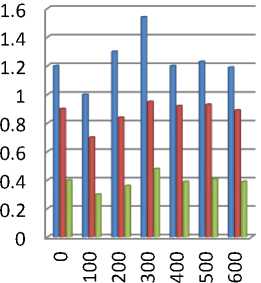
■ ZRP
■ RA-ZRP
■ FRA-ZRP
Fig.8. Graph showing Comparison Analysis of ZRP, RA-ZRP and FRA-ZRP on basis of E2D with varying pause time
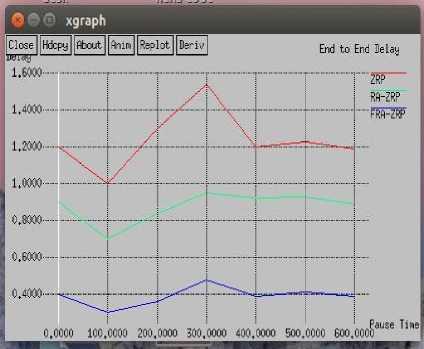
Fig.9. X-graph based simulation analysis of ZRP, RA-ZRP and FRA-ZRP on basis of E2D with varying pause time
-
VI. Conclusion and Future Scope
The segment above has reproduced ZRP and RA-ZRP and FRA-ZRP and accomplished outcomes with the assistance of two quantifiable pointers to check the execution of the proposed calculation. The pointers incorporate Packet Delivery Ratio and End to End Delay. Tables 3., 4. what's more, Fig.6.- 9. delineate that FRA-ZRP guarantees an improved conveyance of information bundle when contrasted with conventional ZRP and RA-ZRP. FRA-ZRP beats customary ZRP and RA-ZRP even as far as End to End Delay by diminishing the postponement and picking up a significant QOS enhancement. This accomplishment can be credited to the development on zone head and fulfillment of course from the head subsequently decreased lining of information parcels because of control bundles, by receiving FRA-ZRP approach.
Список литературы Inculcating global optimization in ZRP through newfangled firefly algorithm
- S. Zafar, D. Mehta, I. Kashyap, “Routing Optimization in Cloud Network” International Journal of Advanced Research in Computer Science, Special Issue, Vol. 8 Issue 2, p16-18. 3p, 2017.
- S. Zafar, D. Mehta, I. Kashyap, “Protract Route Optimization in ZRP Through Novel RA Approach” International Journal of Sensors Wireless Communications and Control, Volume 8, Number 1, pp. 19-25(7), 2018.
- M. Deepa, K. Indu, Z. Sherin, “Neoteric RA Approach for Optimization in ZRP”, Innovations in Computational Intelligence. Studies in Computational Intelligence, vol 713. Springer, Singapore, 2018.
- Z. Sherin, M. Deepa, “Neoteric Iris Acclamation Subtlety”, “Innovations in Computational Intelligence. Studies in Computational Intelligence”, vol 713. Springer, Singapore, 2018.
- D. Mehta, I. Kashyap and S. Zafar, “Synthesized Hybrid ZRP through Aggregated Routes” Int. j. inf. tecnol. 10: 83. https://doi.org/10.1007/s41870-017-0064-1, 2018.
- S. Zafar, D. Mehta, I. Kashyap, “Consummate Scalability through Clustered Approach in ZRP”, International Journal of Sensors Wireless Communications and Control, Volume 7, Number 3, December 2017, pp. 178-187(10), 2018.
- Galvez and A. Iglesias, “Firefly Algorithm for Polynomial Bezier Surface Parameterization” Hindawi Publishing Corporation, Journal of applied mathematics, Volume, Article ID 237984, 2013.
- D. G. Armstrong, D. M. Kleidermacher, et.al., “Cyber Security Regulation of Wireless Devices For Performance and Assurance in the age of “Medjacking” Journal Of Diabetes Science and Technology, Volume 10(2), pp. 435-438, 2016.
- S. M. Farahani, A. A. Abshouri et al. “A Gaussian Firefly Algorithm”, International Journal of Machine Learning and Computing, Volume 1, No. 5, 2011.
- N. F. Johri, A. M. Zain, et al., “Machining Parameters Optimization using Hybrid Firefly Algorithm and Particle Swarm Optimization", IOP Conference Series Journal of Physics: Conf. Series 892(2017) 01, 2005.
- S. Markel, C. W. Becker et al. “Firefly-Inspired synchronization for energy-efficient distance estimation in MANET”, IEEE, 2012.
- L. Zhang, L. Liu et al., “A Novel Hybrid Firefly Algorithm for Global Optimization”, PLOS 1/DOI:101371/Journal.pone.0163230, 2016.
- M. Elkhechafi, Z. Benmamoun et al. “Firefly Algorithm for Supply Chain Optimization”. Lobachtvskii Journal of Mathematic, Volume 39, no. 3, pp. 355-367, 2018
- S. L. Tilahun and J. Medard et al. “Firefly Algorithm for Discrete Optimization Problems: A survey”, KSCE Journal of civil Engineering Korean Society of Civil Engineers, 2017.
- M. S. Manshahia “A firefly based energy efficient routing in wireless sensor networks "African Journal of Computing and ICT (IEEE), 2015.
- A. Loutfi and M. Elkoutbi, “Evaluation and Enhancement of ZRP performances”, International Conference on Multimedia Computing and Systems, Ouarzazate, pp. 1-6, 2011.
- Lakhtaria, KI., “Analyzing Zone Routing Protocol in MANET Applying Authentic Parameter”, 2010.
- F. Rolando J. López et al. “biometric iris recognition using hough transform”. https://ieeexplore.ieee.org/document/6644905/, 2013.
- H. Mühlenbein et al. “How Genetic Algorithms Really Work: Mutation and Hill climbing”, DBLP Conference: Parallel Problem Solving from Nature 2, PPSN-II, Brussels, Belgium, 8-30, 1992.
- C. Blum, and X. Li, “Swarm Intelligence in Optimization”, Natural Computing Series. Springer-Verlag Berlin Heidelberg, 43-85, 2008.
- C. Wook, R. S. Ramakrishna “A Genetic Algorithm for Shortest Path Routing Problem and the Sizing of Populations”, IEEE Transactions On Evolutionary Computation, Volume 6, Issue 6, pp. 566-579, 2002.
- S. Zafar, M. K. Soni “Secure Routing in MANET through Crypt-Biometric Technique”, Proceedings of the 3rd International Conference on Frontiers of Intelligent Computing: Theory and Applications (FICTA), 2014.
- S. Zafar, M. K. Soni, M. M. S. Beg “An Optimized Genetic Stowed Biometric Approach to Potent QOS in MANET” Procedia Computer Science 62, pp. 410- 418, 2015.
- R. Turn, W.H. Ware, “Privacy and Security Issues in Information Systems”. RAND Corporation. Retrieved from https://www.rand.org/pubs/papers/P5684.html, 2012.
- S. Zafar, M.K. Soni “Biometric Stationed Authentication Protocol (BSAP) Inculcating MetaHeuristic Genetic Algorithm” I.J. Modern Education and Computer Science, pp. 28-35, 2014.
- T. Bazaz, S. Zafar, “A Neoteric Optimization Methodology for Cloud Networks”, International Journal of Modern Education and Computer Science(IJMECS), Vol.10, No.6, pp. 27-34, DOI: 10.5815/ijmecs.2018.06.04, 2018.
- N. Zainal, A. M. Zain et al., “Glowworm Swarm Optimization (GSO) Algorithm for Optimization Problems: A State-of-the-Art Review”, Applied Mechanics and Materials, Vol. 421, pp. 507-511, 2013.
- J. Senthilnath, S.N. Omkar and V. Mani, “Clustering using firefly algorithm: Performance study”, Swarm and Evolutionary Computation. Vol. 1, p.164-171, 2011, 2011.
- N.F. Johari, A.M. Zain, et al. “Firefly Algorithm for Optimization Problem”, Applied Mechanics and Materials. Vol. 421 (2013), p. 512-517, 2013.

